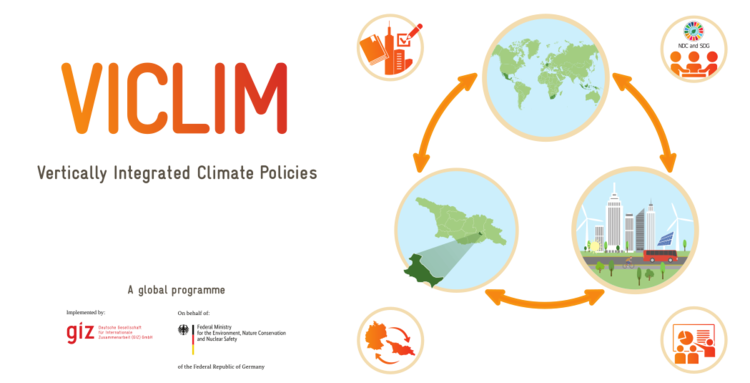Knowledge fuels change
For over a decade, Energypedia has shared free, reliable energy expertise with the world.
We’re now facing a serious funding gap.
Help keep this platform alive — your donation, big or small, truly matters!
Thank you for your support
VICLIM In Georgia
Background
In its (I)NDC[1] document – submitted to the United Nations Framework Convention on Climate Change (UNFCCC) in 2017 – Georgia highlighted the importance of contributions by municipalities in order to reach the country’s overall greenhouse gas (GHG) emissions reduction targets: “It is envisaged that the most intensive pre-2020 mitigation action in Georgia should be the voluntary reduction of GHG emissions committed by thirteen self-governing cities and municipalities [having joined] the EU initiative ‘Covenant of Mayors’ (CoM). Further facilitation of this initiative will [also] significantly contribute to post-2020 [mitigation action].”[2]
This ‘voluntary reduction of GHG emissions’ are found in the ‘Sustainable Energy Action Plans’ (SEAPs) that these thirteen cities and municipalities had developed since 2010[3]. The plans contain mitigation measures in the sectors of transport, buildings, street lighting, waste management, and urban greenery. At the beginning of the 2010s, the political interest at local level in the objectives of the CoM was high because it was a new European initiative and there were the expectations of attracting finances (grants) within the CoM framework and from other donors. As a matter of fact, “municipalities (including large cities such as Tbilisi and Batumi) face severe financial constraints to improve environmental quality and efficiency of infrastructures such as public transport and buildings. The municipal budgets are generally too tight to meet all their investment needs for infrastructure and public services. As a result, public infrastructure investment generally requires allocation of the central government budget and increment finances from multilateral or bilateral sources”[4]. So, in the following years after 2010, some donor-funded projects allowed for implementing some selected measures, e.g. efficient outdoor lighting projects, improvement of public buildings’ energy efficiency, and upgrade of public transport. There was, for example, USAID’s Enhancing Capacity for Low Emission Development Strategies (EC-LEDS) Project[5].
References
- ↑ (Intended) Nationally Determined Contributions
- ↑ Government of Georgia (2017): Georgia’s Intended Nationally Determined Contribution submission to the UNFCCC. https://www4.unfccc.int/sites/ndcstaging/PublishedDocuments/Georgia%20First/INDC_of_Georgia.pdf
- ↑ After 2017, ten more municipalities joined the CoM, but none of them had prepared a SEAP by end of 2019.
- ↑ OECD (2018): Mobilizing Finance for Climate Action in Georgia; page 42. https://www.oecd.org/regional/mobilising-finance-for-climate-action-in-georgia-9789264289727-en.htm
- ↑ https://www.ec-leds.org/countries/georgia




















